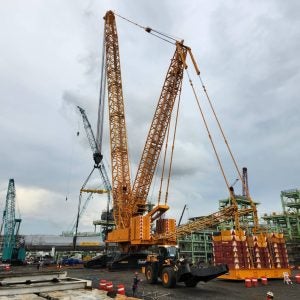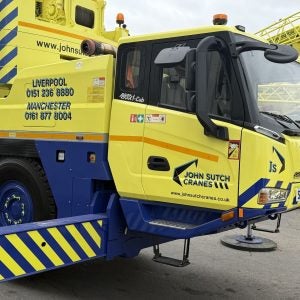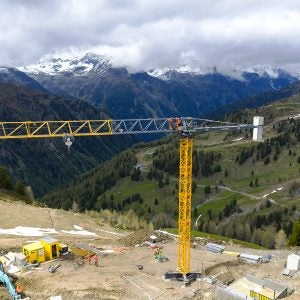Amornthep Latthi, Sino-Thai’s project engineer on the site, said that the site for the new terminal is a long linear one and that it has been necessary to place the two 132 EC-H cranes, and the 100 LC and the 112 EC-H, in line at intervals of about 120m so that the construction of the building can move forward in phases.
"The ground here is medium sand and we are having to do intensive piling, with reinforced concrete piles being sunk to a depth of 20m," he says. "We are then laying our concrete foundation raft, which we are pouring in situ.
"This is all carefully timed, as we need to synchronise each section, and the combination of four tower cranes for the terminal building gave us our optimal configuration.
"We needed long boom reach, but we are not lifting especially heavy loads, the cranes handling mostly steel reinforcement rods and concrete pouring."
"There is limited space on that site, both in terms of the building footprint and the fact that the site is bounded on one side by the access road and on the other by aircraft aprons," said Latthi.
"As we required two tower cranes we decided to purchase the 65 K model, which has a jib length of 40m but which has a 45° obstruction avoidance angle, along with a 30-degree raised jib working angle
Four of the Liebherr units, two 65K cranes and two 132 EC-H cranes, have been purchased new by Sino-Thai, while the company already had the other two, a 100 LC and a 112 EC-H, in its fleet.
The two 132 EC-H cranes have a radius of 55 m and can lift 1.7t at maximum reach, with the maximum lift being 8t.
The 112 EC-H also has a 55m jib and can lift 1.55t at maximum reach, with a maximum of 8t, while the 100 LC has a 50m jib that can lift 1.4t on the jib end and 3t at 2.4m.
The two new 65 K cranes are being used on the cargo building, where the site area is confined.
The cranes were all supplied by Liebherr’s distributor in Thailand, STIT Company Ltd, which is part of the Sino-Thai Group.






